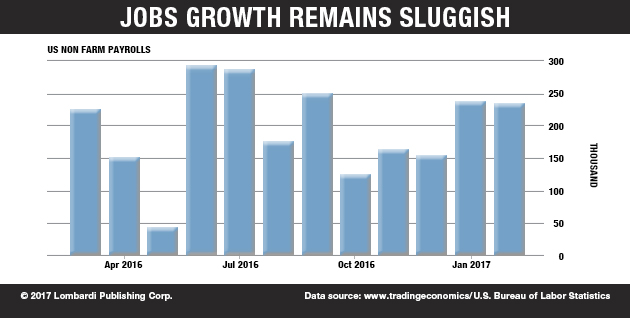Will the U.S. Jobs Reports for the Month of March Strengthen the U.S. Employment Situation for 2017?
It’s okay, but not great. The U.S. job reports for March 2017 is not bad, but it hardly contains the sort of exceptional data that encourages the kind of optimism in the U.S. employment situation many had expected. Indeed, the March 2017 job reports from the U.S. labor market, published on March 10, came after President Donald Trump’s first full month in office.
The U.S employment situation appears to be good—in theory. The United States has created 235,000 jobs in February, which might be better than many expected. But, on closer inspection, the unemployment rate fell to 4.7% from 4.8% last February. That’s statistically insignificant. The U.S. unemployment forecast is far less favorable, and even Trump thinks so.
Given the margins of error and a five-percent variation in actual numbers, the fact is that little changed. Bloomberg estimated an average increase of 200,000 jobs to the economy, while Reuters posted 190,000. Based on January and February statistics, the U.S. economy has actually experienced a net job creation that is only fractions better than the same time last year.
Even if the unemployment rate has dropped under five percent, inflation is rising. That’s why Federal Reserve Chair Janet Yellen raised interest rates at the beginning of March. That’s just the first interest rate increase of at least two others coming before the end of the year. After years of near-zero rates, having to consider interest on loans, could slow down the economy.
The effect will be to offset any gains in real wages that statisticians were “raving” about. Moreover, the inflation rate is difficult to gauge. Europe is not convinced that the time has come to increase rates yet. Many EU economies suffered as bad as, or worse than, the United States did when it faced the economic effects from the 2007/2008 financial crisis.
The European Central Bank (ECB) has upheld its plans to keep interest rates to near-zero levels; that has been the only saving grace for Europe. The ECB governor, Mario Draghi, has managed to keep the German bankers at bay to reduce the risk of the southern economies—even those like Italy, which has a trade surplus—leaving the eurozone. That would have disastrous effects on the global economy.
Too Much Optimism Too Soon About U.S. Jobs Growth
Trump has been in office barely three months. He has not even been able to repeal the one policy he associated with President Obama’s “incompetence,” Obamacare. Yellen, the Fed, and investors on Wall Street may all be operating on false, or at the very least inflated, optimism in U.S. jobs growth.
Not that Yellen is a Trump supporter, but she has approved the rate hike because of widespread expectations that Trump’s policies would generate more employment. Salary increases have been marginal while price increases in shops and even at the fuel pump have been more noticeable for average Americans.
At the time of writing, in fact, the stock market has experienced an eight-session slump. There are concerns that after the Obamacare debacle in the House, whereby Republicans voted not to replace it, Trump may have less room to maneuver the economy than even his voters believed. It’s not his fault.
The cheap rates in the United States—much less in Europe—have created an asset bubble. The Dow reaching beyond 21,000 on pure speculation in the wake of Trump’s tax cuts and growth plans. So far, the record shows, even the Republican Party is divided. If Trump can’t repeal the one policy over which he berated Obama, what other plans will he have to renounce?
Some analysts might emphasize the positive aspect of the latest monthly employment growth statistics. The most widely touted of these concerns wages. Apparently, hourly wages increased 2.8% on an annual basis, as forecast by analysts. But the increase on a monthly basis was 0.2%, less than analysts’ predictions of 0.3%. In addition, wages increased only 0.1% in the first month of the year.
The rate of labor force participation has risen on his part to 63% from 62.9% in January. What does that rate indicate? Simply that an increasing number of people over the age of 16 are working or looking for a job now. The statistic represents a strong indication of sentiment for the economy. (Source: “Labor force participation moves up,” Business Insider, March 10, 2017.)
When it drops, as it dramatically did after the start of the 2007 crisis, it suggests that there are so few jobs that few have even hope of finding one. So, they don’t even look—officially, at least. Thus, the labor force participation moving up would point to greater optimism. And how much did this important indicator increase? It rose by a whole 0.1% from 62.9 to 63.0%. (Source: Ibid.)
The Fed Raised Rates, But…
Overall, based on a strict observance of the numbers, economists could make the argument that the Federal Reserve had a case to raise rates. But, the job growth trend, while positive was predicated on zero interest. That means there are no assurances that the U.S. economy can continue to support the current U.S. job growth rate, that is at the pace noted last March.
There’s no guarantee that the next jobs report will continue to show even the modest progress of the last. There is an illusion of growth because the markets have had an admittedly stellar performance. However, eight consecutive bearish performances may induce a much-needed reality check, as it were. U.S. jobs growth was far better last summer than in January and February.
Americans will be reminded of the signals that followed equally stellar gains before the October 1929 crash. Just as before a major earthquake or volcanic eruption, there are warning shocks. President Trump’s setbacks with Obamacare have acted as a wake-up call for investors. They are no longer convinced that the economy could grow as much as the markets’ performance might suggest.
The employment numbers in early March are not all that great, overall. However, Wall Street treated it as a “solid” indicator because, spun the right way, it helped push valuations higher, fueling the bubble. Investors forget that what might be good for Wall Street often fails to benefit Main Street, that is the real economy: families and businesses.
Nothing has occurred to divert this dichotomy, which has been the problem everybody sees but nobody calls. The fact is that prospects favor more U.S. job cuts than U.S. job growth. So many of the jobs that have accounted by the recent optimistic stats are hardly jobs to cheer about. Sure, they might be good for students, to help pay for their college fees or entertainment.
Unemployment Vs. Underemployment
Working in a modestly—at best—paid retail or food industry job is hardly the stuff of childhood dreams. The jobs so many talking heads rave about on CNBC and CNN are of the low-wage variety. But, worse than unemployment is the phenomenon of underemployment. That is the phenomenon that occurs when people possessing a certain experience and/or education are forced to take jobs for which they are overqualified.
Often, to get such jobs, and to maintain a modicum of survival, the prospective employee might even have to feign ignorance. I personally know people with graduate degrees who have had to hide they even had an undergraduate education in order to land a “prestigious” post as a waiter or a cashier while waiting for that “opportunity” to appear. Well, fewer opportunities appear nowadays.
The sad truth is that most people will no longer be able to earn as much as they did before the 2007/2008 crash. That creates a dilemma of morale. The perception of economic underperformance, beyond the wheeling and dealing of Wall Street, is palpable among the underemployed.
But that would be an unfair argument, because it enters the realm of sociology. Yet, even if we keep the topic limited to statistics, the picture is negative. The number of Americans who applied for unemployment benefits rose according to statistics published in mid-March. It seems that U.S. jobs growth per year is already experiencing a setback.
New requests for unemployment benefits reached 258,000 in the week that ended March 18, 2017, or worse than expected. That number fares rather badly, given that the Department of Labor estimated the jobless claims to be no more than 240,000. (Source: “US weekly jobless claims total 258,000 vs 240,000 estimate,” CNBC, March 23, 2017.)
But, even those numbers do not tell the story. A less skewed analysis that takes a look at the hidden “statistics” that the rosy stories of the The New York Times or CNN don’t report is that one in four Americans of prime working age is jobless now. Even adjusting for the three years since that article was written, little has changed. Even if the ratio of unemployed Americans were closer to one in five, it should still raise eyebrows the next time you hear how high the Dow Jones has reached. (Source: “1 in 4 Americans 25-54 Not Working,” The Weekly Standard, September 26, 2014.)
The U.S. economic model, unfortunately, might be free market. But, over the last few decades, it has lost its anchors. It has developed in such a way that a small minority enjoys outrageous compensation while for others, there is not much beyond high unemployment and underemployment.







